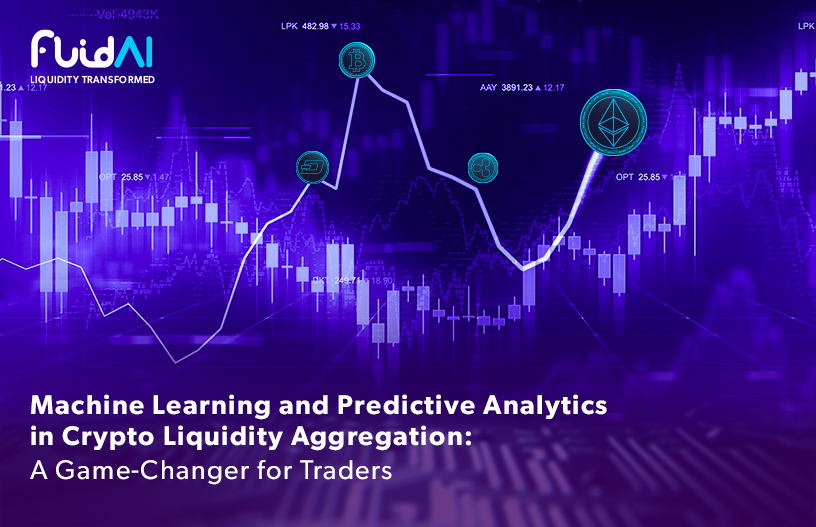
Machine Learning and Predictive Analytics in Crypto Liquidity Aggregation: A Game-Changer for Traders

Machine Learning and Predictive Analytics in Crypto Liquidity Aggregation: A Game-Changer for Traders
Key Takeaways:
- The integration of machine learning (ML) and predictive analytics with blockchain technology has enhanced security and fraud detection in the finance and insurance sectors.
- ML algorithms analyze blockchain data to identify patterns and anomalies, minimizing financial losses and improving trust in the system.
- ML and predictive analytics have revolutionized liquidity aggregation in cryptocurrency trading. Traders can leverage ML algorithms to predict liquidity levels, optimize trade execution, aggregate prices, and assess trading risks.
- Predictive analytics provides insights into market trends and real-time monitoring, enabling traders to make informed decisions and capitalize on favorable conditions.
In the fast-paced world of cryptocurrency trading, liquidity plays a vital role in determining the efficiency and profitability of trades. Fortunately, the rise of liquidity aggregation platforms has provided traders with powerful tools to connect to multiple cryptocurrency exchanges, granting them access to a wider pool of liquidity and the ability to execute trades at competitive prices.
However, the advent of ML and predictive analytics has propelled liquidity aggregation to new frontiers, revolutionizing the way traders navigate the crypto markets. In this blog, we will delve into the transformational impact of ML and predictive analytics and how they have become indispensable tools for traders in the world of crypto liquidity aggregation.
In this blog, we will explore how ML and predictive analytics have become game-changers for traders in the realm of crypto liquidity aggregation.
But First, How Did ML Enter Blockchain?
The integration of ML and predictive analytics with blockchain technology has gradually emerged as a natural progression in the pursuit of leveraging data-driven insights and enhancing the capabilities of blockchain networks. Machine learning, with its ability to learn from data and improve performance, has found a natural fit within the blockchain ecosystem.
One of the key advantages of incorporating ML into blockchain is enhanced security. By utilizing ML algorithms to govern the blockchain, the system can detect and prevent potential security threats more effectively. These algorithms can analyze vast amounts of data and identify patterns or anomalies that indicate suspicious activities, thereby bolstering the security of the blockchain network.
ML algorithms thrive on large datasets, and blockchain, with its distributed ledger, offers a wealth of data for analysis. By leveraging the decentralized nature of blockchains, these models can access a diverse range of data from multiple sources, leading to more accurate and robust models.
One notable application of ML is in the finance and insurance sectors, particularly in fraud detection. ML algorithms can analyze transactional data on the blockchain and identify fraudulent patterns or suspicious behaviors. By combining the transparency and immutability of blockchain with the predictive capabilities of machine learning, fraud transactions can be identified and prevented more efficiently, minimizing financial losses and enhancing trust in the system.
The integration of ML opens up new avenues for innovation and improved functionalities. The combination of these two technologies can revolutionize various sectors, including finance and insurance, by enhancing security, leveraging decentralized data, and enabling more effective fraud detection mechanisms.
The Role of ML and Predictive Analytics in Liquidity Aggregation
Understanding the power of ML and predictive analytics in the context of liquidity aggregation requires recognizing their role in unlocking unprecedented trading opportunities and optimizing decision-making. By harnessing the capabilities of ML algorithms, traders gain access to advanced analytical techniques that can sift through vast amounts of historical and real-time data. This enables them to make accurate predictions, automate trading decisions, and ultimately seize advantageous market positions.
The integration of predictive analytics further enriches liquidity aggregation by enabling traders to analyze and forecast future market trends, liquidity levels, and trading opportunities. By leveraging historical and real-time data, predictive analytics models provide insights into market dynamics, empowering traders to make informed decisions and adapt to ever-changing market conditions. Furthermore, real-time market monitoring capabilities enable traders to promptly identify potential opportunities or risks, allowing them to capitalize on favorable conditions and mitigate potential losses.
ML has made significant contributions to liquidity aggregation in the realm of cryptocurrency trading. By harnessing the power of ML algorithms, liquidity aggregation platforms have been able to enhance trading efficiency, improve price discovery, and reduce risks. Here are some key ways in which ML is utilized in liquidity aggregation.
Liquidity Prediction: ML algorithms can analyze historical trading data, order book information, and market depth to predict liquidity levels across multiple exchanges. By identifying patterns and trends, these algorithms help traders anticipate liquidity fluctuations and make informed trading decisions.
Smart Order Routing: ML algorithms can dynamically analyze liquidity across different exchanges in real-time, determining the most suitable exchange to route orders based on factors such as available liquidity, order size, and trading costs. This enables traders to optimize execution and achieve better fill rates.
Price Aggregation: ML models can aggregate and analyze prices from various exchanges, taking into account factors such as order book depth, trading volumes, and historical price movements. By selecting the best prices across multiple exchanges, traders can achieve more competitive pricing and improved profitability.
Risk Assessment: ML algorithms can assess the risk associated with individual trades or trading strategies by analyzing historical data and market conditions. This helps traders identify potential pitfalls and adjust their strategies accordingly, thereby reducing the risk of adverse outcomes.
Predictive Analytics in Liquidity Aggregation
Predictive analytics, another powerful tool in the realm of liquidity aggregation, involves using historical and real-time data to forecast future market trends, liquidity levels, and trading opportunities. Here’s how predictive analytics complements MLin crypto liquidity aggregation:
Market Trend Analysis: Predictive analytics models can analyze historical data and identify trends and patterns that can guide traders in understanding market dynamics. By understanding historical price movements and liquidity patterns, traders can make more informed decisions and better adapt to changing market conditions.
Real-time Market Monitoring: Predictive analytics models can continuously monitor real-time market data, order book depth, and trading volumes to identify potential opportunities or risks. By providing traders with timely alerts and insights, these models enable them to react swiftly and capitalize on favorable market conditions.
Trade Execution Optimization: Predictive analytics models can assess different trade execution scenarios and recommend optimal strategies based on historical data and real-time market conditions. This helps traders maximize profitability by optimizing execution timing, order sizes, and trade routes.
FLUID’s AI Engine

ML and predictive analytics have transformed crypto liquidity aggregation, empowering traders with enhanced decision-making capabilities and better trading outcomes. By leveraging these technologies, traders can access a broader pool of liquidity, achieve competitive pricing, and reduce trading risks. The combination of machine learning’s ability to analyze vast amounts of data and predictive analytics’ forecasting opens up new possibilities for traders in the crypto markets.
Research studies have indicated that statistical quant models work but are limited in predictive accuracy due to their linear nature and inability to comprehend various variables of mass data. By utilizing machine learning and deep learning, FLUID is able to comprehend a whole multitude of macro and micro economic variables and sentiment features that are needed to predict the price of an aggregated order book more precisely.
FLUID’s hybrid cryptocurrency prediction model can determine how cryptocurrencies trade on exchanges. It predicts price, volume, volatility, and liquidity up to two minutes into the future with high accuracy. It combines various powerful methods from deep learning such as recurrent neural networks (RNN) and support vector machines (SVM).
Cryptocurrency markets possess complex characteristics because there are numerous interacting elements in the markets and many nonlinear features. This complexity is due to the vast volatility and a large number of data points, making it a challenge when using traditional methods to conduct prediction. FLUID seeks to improve the prediction of cryptocurrency order book prices in a time series with its nonlinear nature and complexity by introducing Machine Learning, a subset of AI.













